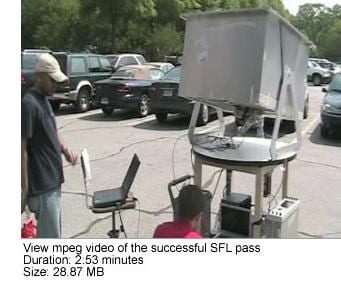Exploring Array Reception of the EO-1 Downlink
Mary Ann Ingram, Thomas Pratt, Paul Steffes, and John Langley
A new adaptive antenna array architecture for low-earth-orbit satellite
ground stations has been investigated. These ground stations are intended
to to have no or a minimum of moving parts and could potentially be operated
in populated areas, where terrestrial interference is likely.
The architecture includes multiple, moderately directive phased arrays.
The phased array technology considered in this project is the space-fed
lens (SFL), which consists of a low-cost printed circuit forming the
lens, and an arrangement of feed antennas on the focal surface. For this
project, we considered electronic steering in elevation only, so the
feed antennas were arranged on a focal arc. With each SFL steered in
the approximate direction of the satellite, the SFL outputs are adaptively
combined to enhance the signal-to-interference-plus-noise (SNIR) of the
desired satellite. Parameters in the system design include the size of
each SFL, the number of SFLs, and the number of feeds per SFL.
An additional benefit of the multi-feed architecture of the SFL, as
well as lens-type antennas in general, is that more than one satellite
can be tracked at a time. If two co-channel satellites are in the field
of view of the SFL, then the illuminated feeds can jointly demodulated.
If there is any crosstalk between the signals because of non-zero sidelobes
of the SFL beam pattersn, then multiuser detection techniques can be
employed to suppress the crosstalk. When the satellites are in the same
band, this approach amounts to the application of space division multiple
access (SDMA) to LEO satellites.
In Phase I of the project, fixed directional elements are adaptively
combined in a prototype to demodulate the S-band downlink of the EO-1
satellite. This phase was reported in the paper entitled “Optimizing
satellite communications with adaptive and phased array antennas.”

Two additional demonstrations were performed: one using an array of
inflatable dish antennas and the other using a space-fed lens.
Both demonstrations used the X-band transmissions of the SAC-C satellite.
The inflatable dishes were mounted on a single planar frame, which
was steered by a Mead positioner. The Mead positioner had a telescope
in the center of the array, and its calibration for each pass was performed
the evening before on selected stars. The purpose of the SFL demonstration
was to show that our tracking system worked. The SFL pointing direction
was calibrated using GPS coordinates of the SFL and of one of the prominent
buildings in the Atlanta, Georgia skyline. Then the ephemeris provided
by the Heavenscape software was used to program a microprocessor controller
of a stepper motor (for azimuth steering) and a switch network (for
elevation beam switching).
To lower costs and reduce latency, a network of adaptive array ground
stations, distributed across the United States, is considered for the
downlink of a polar-orbiting low earth orbiting (LEO) satellite. Assuming
the X-band 105 Mbps transmitter of NASA’s Earth Observing 1 (EO-1) satellite
with a simple line-of-sight propagation model, the average daily download
capacity in bits for a network of adaptive array ground stations is compared
to that of a single 11 m dish in Poker Flats, Alaska. Each adaptive array
ground station is assumed to have multiple steerable antennas, either
mechanically steered dishes or phased arrays that are mechanically steered
in azimuth and electronically steered in elevation. Phased array technologies
that are being developed for this application are the space-fed lens
(SFL) and the reflectarray. Optimization of the different boresight directions
of the phased arrays within a ground station is shown to significantly
increase capacity; for example, this optimization quadruples the capacity
for a ground station with eight SFLs. Several networks comprising only
two to three ground stations are shown to meet or exceed the capacity
of the big dish. Cutting the data rate by half, which saves modem costs
and increases the coverage area of each ground station, is shown to increase
the average daily capacity of the network for some configurations. The
paper reporting these results is “LEO
download capacity analysis for a network of adaptive array ground stations.”
Last
revised on May 26, 2006.

